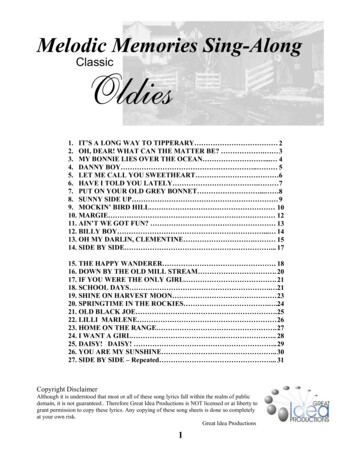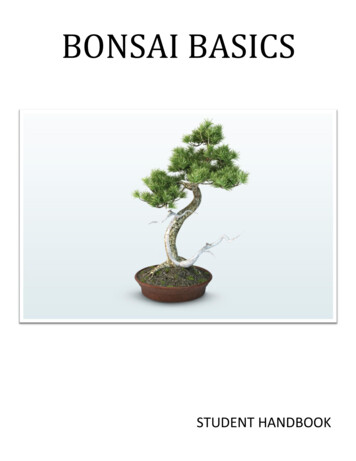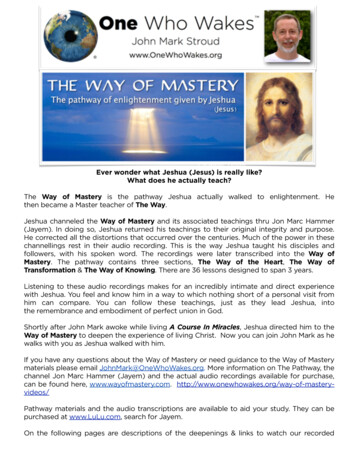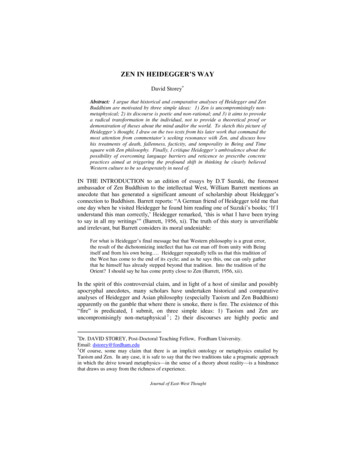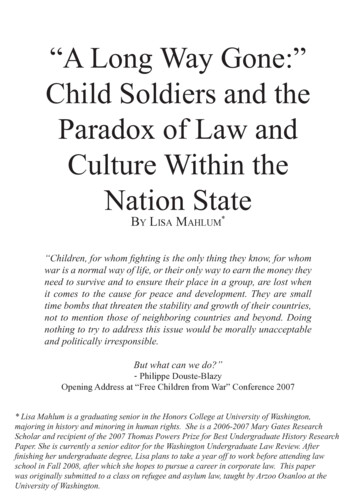
Transcription
THE WAYa review of Christian spirituality published by the British JesuitsJuly 2020Volume 59, Number 3MOVED BYCONVERSATION
THE WAYJuly 2020ForewordPsychological Foundations of Interior Movements5–67–14Roger DawsonIn his teaching on discernment of spirits, which lies at the heart of the SpiritualExercises, Ignatius speaks of ‘movements’ that are experienced within thesoul and can to some extent be understood. Here Roger Dawson relatesthese movements to recent psychological research, particularly to theoriesof the emotions, both positive and negative.Communicating Jesuit Mission Today: The UniversalApostolic Preferences15–22Damian HowardIn 2019 the Jesuits worldwide adopted four ‘Universal Apostolic Preferences’,intended to guide and shape the mission of the Society of Jesus over thenext decade. Using an image from the film The Matrix, the British JesuitProvincial, Damian Howard, shows how these preferences might be used tohelp communicate this mission more effectively.The Treasures of Darkness: Poetic Musings towards aSpiritual Theology of Darkness23–39Bonnie ThurstonMuch spiritual writing presents light as an image of everything good, withits counterpart, darkness, as a symbol of evil, or at least of all that should beshunned and avoided. By contrast here Bonnie Thurston, drawing on bothscripture and poetry, finds much in the idea of darkness that is positive,and that can usefully be incorporated into a developing spiritual journey.The Spirit in Contemporary CultureArtificial Intelligence: A Theological ApproachCalum SamuelsonArtificial intelligence is at the cutting edge of current technological innovation,and the full implications of its development for humanity are as yet far fromclear. Calum Samuelson approaches it as ‘a tool that amplifies human natureand behaviours’, and explores how theological ideas can illuminate aspectsof its realisation.41–50
THE WAYJuly 2020Joining the Conversation51–66Robert GreenRobert Green was raised in a Christian tradition that regarded the Bible as akind of infallible divine instruction manual. He responds to this view here withthe idea of ‘sacred conversation’, continuing to see scripture as a bearer of truthwhile offering a more nuanced understanding of how that truth is conveyed.It is, he holds, the Bible itself that serves to initiate these conversations.Memory in the Spiritual Exercises and John 2167–76Gerald O'CollinsBoth Ignatius’ Spiritual Exercises and the final chapter of John’s Gospel relyheavily on the concept of memory to make their impact. Gerald O’Collinsshows here how memory enables the experience of being a loved andforgiven sinner, with an awareness of all the gifts that God continues tooffer, to deepen Christian discipleship.Helping Others: The Role of Conversations and of theSpiritual Exercises77–88Patrick GoujonAt the heart of the Spiritual Exercises lies the experience of conversation:between the director and the one being directed and, more importantly, betweenthe exercitant and God in prolonged prayer. In this extract from a longerwork Patrick Goujon considers how these conversations work, in a way thatis unique to each person involved.Thinking FaithCoping with Insecurity, Uncertainty and Risk89–96Helen FreemanHelen Freeman is both an ordained rabbi and a qualified Jungian analyst.Here she argues that the ‘dominion over creation’ to humans in the Book ofGenesis does not allow us to escape through material things from an insecurityinherent in being a creature, and that the security that we crave can onlybe found in God.Small Christian Communities: Rejuvenating the ChurchJohn ZupezOne of the results of the isolation forced upon many by the coronaviruspandemic has been a deepened appreciation of the value of community. Infact the Church had already, in recent decades, been coming to a similarconclusion. John Zupez describes a number of projects from across the worldthat illustrate this renewed insight.97–109
THE WAYJuly 2020Book ReviewsTim Noble on the thought of Pope FrancisBrendan Callaghan on surviving childhood abusePeter Groves on Rowan Wiliams’s christologyPatricia Harriss on the writings of Sr Mary DavidHenry Shea on death and dying in the Christian traditionGavin Murphy on Christianity and mindfulnessDavid Lonsdale on eschatalogical ecclesiology and a new book about JohnHenry NewmanAlan Salmon on the spirituality of Thomas MertonFOR AUTHORSThe Way warmly invites readers to submit articles with a view to publication. They should normally be about4,000 words long, and be in keeping with the journal’s aims. The Editor is always ready to discuss possibleideas. A Special Issue is planned on Pope Francis, so articles in this area will be particularly welcome.ACKNOWLEDGEMENTSWe are grateful to Jay Carney and Tom Landy for permission to reprint the photograph on page 101.Thanks to Peter Brook SJ for additional illustrations. The scripture quotations herein are generally fromthe New Revised Standard Version Bible 1989 by the Division of Christian Education of the NationalCouncil of the Churches of Christ in the USA, and are used by permission. All rights �Reminiscences (Autobiography)’, in Ignatius of Loyola: Personal Writings, translated byPhilip Endean and Joseph A. Munitiz (London: Penguin, 1996)in The Constitutions of the Society of Jesus and Their Complementary Norms (St Louis:Institute of Jesuit Sources, 1996)Diary‘The Spiritual Diary’, in Ignatius of Loyola: Personal Writings, translated by Philip Endeanand Joseph A. Munitiz (London: Penguin, 1996)DirOn Giving the Spiritual Exercises: The Early Manuscript Directories and the OfficialDirectory of 1599, translated and edited by Martin E. Palmer (St Louis: Institute of JesuitSources, 1996)ExxThe Spiritual Exercises of Saint Ignatius, translated by George E. Ganss (St Louis: Instituteof Jesuit Sources, 1992)GCGeneral Congregation, in Jesuit Life and Mission Today: The Decrees and AccompanyingDocuments of the 31st – 35th General Congregations of the Society of Jesus (St Louis: Instituteof Jesuit Sources, 2009) and Jesuit Life and Mission Today: The Decrees and AccompanyingDocuments of the 36th General Congregation of the Society of Jesus (Boston: Institute ofJesuit Sources, 2017)MHSJMonumenta Historica Societatis Jesu, 157 volumes (Madrid and Rome: InstitutumHistoricum Societatis Iesu, 1898– )Papal documents may be found at www.vatican.va
FOREWORDwas a key skill that Ignatius hoped todevelop in the early Jesuits. As men educated in Renaissancehumanism, debate came naturally to them, and to this they brought adetermination to listen deeply to other points of view, whether those ofthe Protestant reformers in Europe or of the new and diverse culturesthey encountered on their missionary journeys. To engage in spiritualconversation is not artificially to restrict talk to ‘holy’ subjects, butrather gradually to let a conversation deepen, to the point where bothparties are able to recognise the God who is at work everywhere in theworld and within each human heart. This conversational art has lostnone of its relevance over the last five centuries.In this issue of The Way Patrick Goujon looks at how conversationsof this kind have a key role to play in the experience of the SpiritualExercises. Robert Green suggests that such conversation is a powerfulway of coming to understand the way in which the truths of scriptureare conveyed, in patterns that go beyond a belief in the Bible as simplythe ‘maker’s instructions’ for humanity. The contribution by John Zupezhighlights the role of small communities within the contemporaryChurch—communities in which the faith can be shared and spreadthrough conversation, rather than only by one-way preaching.At its best, spiritual conversation is alert to, and follows, themovements of God’s Spirit as they make themselves known in ourexperience. Roger Dawson relates this idea to psychological theories ofthe emotions, positive and negative. Bonnie Thurston picks up on the ideathat God can be recognised even in experiences that are often rejectedas negative, drawing on poetry to find God active in darkness as well asin light. For Gerald O’Collins, memory has a central role to play inenabling a continuing response to the movements of spirit, building onwhat it is that God is doing, and he illustrates this from the encountersdescribed at the end of John’s Gospel.This view of conversation recognises it as an important way in whichthe word of God is communicated. Damian Howard draws on a strikingimage from the science fiction film The Matrix to explore aspects ofcontemporary divine communication. Alan Turing famously suggestedthat the test for successful artificial intelligence would be whether itSPIRITUAL CONVERSATIONThe W ay, 59/3 (Ju ly 2020), 5– 6
6Forewordcould conduct a conversation indistinguishable from one with anotherhuman being. As this possibility comes ever closer to being realised,Calum Samuelson employs theology to approach it with optimism. AndHelen Freeman explores the long cultural conversation within Judaismabout how the dominion over Creation bestowed by God on Adamshould be interpreted and lived.The limitations on face-to-face contact brought about by thecurrent coronavirus pandemic have had, for many, the unexpected effectof underlining the importance of conversation, and have promptedinitiatives to enable it to continue. Zoom webinars have replaced businessconferences, Skype calls allow family members to keep in touch, and inreligious circles live-streaming of services and virtual gatherings havebecome much more common. It is too early to say how much of this willcontinue into the post-pandemic period. But human beings will alwaysbe fundamentally social animals, and the God who became incarnaterespects these ways of making Godself known. To publish an article isitself an invitation to conversation, if only within the mind of the reader.It is our hope that the varied contents of this issue of The Way willstimulate you to respond to what is said here, and thus to keep theconversation alive.Paul Nicholson SJEditor
PSYCHOLOGICALFOUNDATIONS OFINTERIOR MOVEMENTSRoger DawsonIN THE IGNATIAN TRADITION, movements (motions or mociones) relate tothe interior experiences of the soul. According to Michael Ivens, they‘refer to interactions of feelings, thoughts and impulses of attraction andrecoil which occur spontaneously in consciousness’.1 These movementsare involuntary and can come from the self, a ‘good spirit’ or a ‘bad spirit’and freedom consists in the choice we have to accept or reject the directionin which they propel us. These movements or interior experiences canrelate to the intellect (thoughts, reasoning, imaginings), the will (urges,impulses, desires) or affect (mood and emotions). Consolation anddesolation as understood in the Spiritual Exercises are spiritual becausethey have God as their object and are felt reactions to God and God’struth. Consolation is a positive reaction to God, while desolation is anegative reaction to God—pulling away or closing in on the self.While movements do not solely refer to feelings and emotions, Iwould like to approach them here through two theories of emotion thatcome from recent psychological research. The first is Paul Gilbert’sevolutionary theory of three systems or ‘modes’ of affect regulation, andthe second is Barbara Fredrickson’s ‘broaden and build’ theory of positiveemotions. I believe that both these theories can help us to understandthe foundations of the movements or motions that interest us inIgnatian spirituality generally and in discernment specifically. I amtaking a strictly incarnational approach: in line with the tradition ofCatholic anthropology I am treating the human person as a biological,This article is based on a lecture offered at the International Symposium on Psychology and SpiritualExercises (Loyola, 20–24 June 2019), and a Spanish translation will appear in the Acta of the Symposiumin 2021.1Michael Ivens, Understanding the Spiritual Exercises (Leominster: Gracewing, 2004), 210.The W ay, 59/3 (Ju ly 2020), 7– 14
8Roger Dawsonpsychological and spiritual unity, and am assuming that very little can beexperienced or done without a body and a brain. As far as we can tell, it isonly with this body and brain that we can experience interior movements.Three Systems of Affect RegulationThe first theoretical approach I want to look at comes from research intothe development of compassion-focused approaches in cognitive therapy.This takes an evolutionary perspective on the long development of thehuman brain.The cognitively modern human brain emerged only about 200,000years ago but is built on the much older parts that we share with ourancestors. The oldest and most primitive part of the brain is known asthe ‘reptile brain’. This part is strictly territorial and is concerned withdanger and the ‘fight or flight’ response; its main emotions are anxiety,anger and disgust. Once humans started to live in groups the limbic systemdeveloped, a more sophisticated part of the brain concerned with socialfunctioning and belonging, and the emotions associated with kinship.Finally, the outer part of the brain, the cortex, developed and is associatedwith the higher functions of reasoning, planning and verbal skills.There is a hierarchy here: it is hard for the cortical brain to overridethe powerful, primitive response of the reptile brain, largely associatedwith negative emotions, which may be unpleasant but are powerful signalsthat all is not well and have helped us to stay alive. Paul Gilbert hasidentified three ‘systems’ of affect regulation associated with this brain
Psychological Foundations of Interior Movements9architecture.2 The first is the ‘threat and self-protection’ system (threatmode) and this is related to the reptile brain. This system keeps us safeby scanning for danger and detecting threats quickly, and it triggers themain emotions (anxiety, anger,
The first is Paul Gilbert’s evolutionary theory of three systems or ‘modes’ of affect regulation, and the second is Barbara Fredrickson’s ‘broaden and build’ theory of positive emotions. I believe that both these theories can help us to understand the foundations of the movements or motions that interest us in Ignatian spirituality generally and in discernment specifically. I am .



